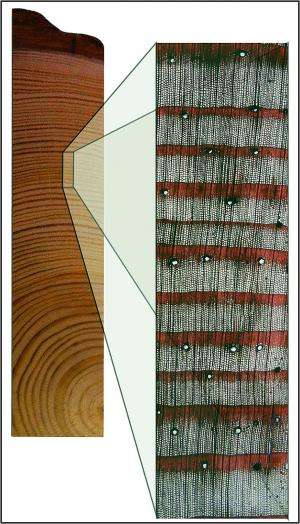Understanding the Earth's climate prior to the industrial era

Tree-rings, ice-cores, and speleothems are all used to reconstruct climate of the past millennia. But are these records reliable? Researchers of the Swiss Federal Research Institute WSL, the University of Bern's Oeschger Center, and the University of Mainz have found out that yearly temperature and precipitation variation and extremes have previously been underestimated in comparison to longer-term climatic trends. These findings were just published in an early release issue from the renowned journal Nature Climate Change.
Climate signals locked in the layers of glacial ice, preserved in the annual growth rings of trees, or fingerprinted in other so-called proxy archives such as lake sediments, speleothems, and corals allow researchers to quantify climate variation prior to instrumental measurements. An international research team has now investigated hundreds of these proxy records from across the globe and compared them with both simulations of the Earth's climate and instrumental measurements of temperature and precipitation.
Climate extremes not always recognized in proxy archives
The scientists learned that these proxy archives provide an incomplete record of climate variation. The annual width or density of tree-rings is not only influenced by temperature while the ring is developing, but also from the climate of the past years and other factors like tree age. This makes it difficult to extract pure temperature signals from these natural archives. Importantly, the researchers found out that proxy data underestimate climate fluctuations of, for example, air temperature over the land surface where large year-to-year variability is common. In contrast, long-term trends in precipitation tend to be exaggerated by the proxy records. These findings indicate that the proxy data often result in a "blurry picture" of climate variation. The researchers were able to conclude from their work that short-term extreme climate events, such as individual years with hot summers, are not well captured by the proxy reconstructions.
Temperature trends can't be used to understand rainfall
Investigations on the individual factors and processes fingerprinted in tree-ring, ice-core and speleothem records are needed to develop a more accurate history and understanding of the climate system. The authors explicitly warn that proxy records that predominately reflect temperature variation should not be used to make conclusions about precipitation change and vice-versa. "Our results point to uncertainties in the global climate system that were previously not recognized," says David Frank, co-author of this study. He continues "This might be surprising because we know more about the Earth's climate now than say 20-years ago. Part of the scientific process is to confront and uncover these unknowns while developing climate reconstructions." There is still a lot of basic research needed to reduce uncertainties about how the Earth's climate system operated prior to the industrial era and how it may operate in the future.
More information: Franke, J., Frank, D., Raible, C.C., Esper, J. and Brönnimann, S. (2013), Spectral biases in tree-ring climate proxies. Nature Climate Change, doi:10.1038/nclimate1816.
Journal information: Nature Climate Change
Provided by Swiss Federal Institute for Forest, Snow and Landscape Research

















